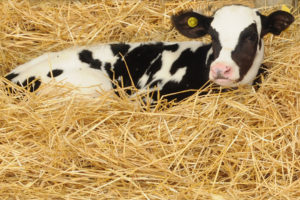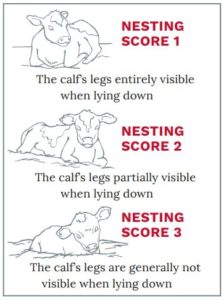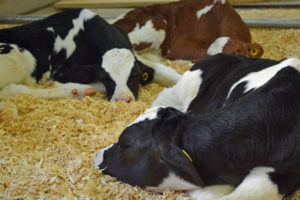Healthy Calf Conference
Follow to stay up-to-date on all Healthy Calf Conference updates. Speaker announcements, sponsorship information, registration announcements, and more.
Calf managers want simple and economical solutions to their calf health challenges. Not every problem can be solved with an easy solution, but three winter calf care challenges – respiratory disease, scours, and reduced growth – can all be minimized with one simple solution: deep straw bedding.

Each day, calves spend up to twenty hours, or 80 percent of their time, laying down. Just like cows make more milk when they spend more time laying down, research suggests that calves who spend less time laying down have reduced growth. Laying down is also considered a sign of comfort – calves that are not well adjusted to their environment may spend more time standing.
When winter temperatures arrive, keeping calves warm is key. As calves are often laying down, management that makes their laying space warmer and more comfortable should be a priority.
Deep straw bedding allows a calf to nest and trap warm air around their body. When calves are laying down, you shouldn’t be able to see their legs. Usually 3-4 inches (7.6-10 centimetres (cm)) of shavings topped with 12 inches (30 cm) of straw is ideal.

Test the bedding by kneeling in it for about 30 seconds. If you end up with wet knees, you need to add fresh bedding. You can also have your calves perform the knee test for you. If their knees are wet or have manure/bedding build up on them, you need to add more bedding. Calves actively avoid laying on wet bedding if given a choice.

Calves won’t be able to spend most of their day laying down if their pen is too small. Space per calf is especially important in group housing – all calves need to be able to lay on the bedded area at once. Make sure calves call all lay down in a sternal position (on their chest with legs tucked under them) as well as laterally (flat on their side with legs stretched out).
Add bedding often instead of adding large amounts all at once. This will keep the top layer fluffy (rather than compacted) and dry.
Straw is more absorbent than shavings, which helps keeps calves dry. A wet calf is a cold calf. Keeping calves warm reduces the incidence of respiratory disease, and straw is the warmest bedding type (compared to alternatives such as shavings, sand, rice hulls, or non-organic options).
A study by Panivivat et. al. in 2003 found that calves on straw had the fewest scour days, which lead to the lowest antibiotic use in those calves compared to calves on rice hulls, shavings, granite fines, and sand. In contrast, the study also found that by day 14, wheat straw had the highest bacteria level. This could be due to bedding management during the trial. Every two weeks, only a small amount of bedding was added. More frequent bedding management and a greater amount of bedding added each time could reduce this negative impact. Remember to do the knee test frequently and add bedding generously.

Feeding more milk in winter is recommended but increasing milk won’t make up for wet or shallow bedding. In the winter, do you grab a sandwich to keep you warm during chores or do you put on a coat? Some people do both – and your calves would appreciate both as well.
In a study by Hill et. al. (2007), when milk allowance was 0.908 kilograms/day (kg/d) (6 litres/day) and calves were bedded with straw, these calves had a 12 percent higher average daily gain than calves on a lower milk allowance of 0.681 kg/d (4.5 litres/day) housed on shavings. If milk replacer amount is the same, calves on straw still grow five percent faster. Combining an increased amount of milk replacer with deep straw bedding will help your calves hit their growth targets sooner, despite cold temperatures.
When just a few of the benefits of straw include improved growth, reduced illness, and improved calf comfort, this simple and economical management change will make winter a lot easier on your future herd.
Follow to stay up-to-date on all Healthy Calf Conference updates. Speaker announcements, sponsorship information, registration announcements, and more.
The Codes of Practice are nationally developed guidelines for the care and handling of farm animals. They serve as our national understanding of animal care requirements and recommended practices.